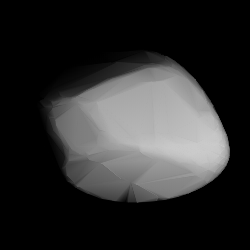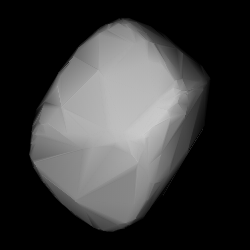
283 Emma is a large asteroid of the asteroid belt and the namesake of the Emma family. It was discovered by Auguste Charlois on 8 February 1889, in Nice, France. The reason for its name is unknown.

Columbia is a stony asteroid from the middle region of the asteroid belt, approximately 26 kilometers in diameter. It was discovered on 22 March 1892, by French astronomer Auguste Charlois at Nice Observatory in southeast France. It is named after Christopher Columbus (1451–1506).

Ursula, provisional designation 1893 AL, is a dark asteroid and parent body of the Ursula family from the outer regions of the asteroid belt. It is one of the largest asteroids with a diameter of approximately 200 kilometers. It was discovered on 18 September 1893, by French astronomer Auguste Charlois at Nice Observatory in France. The referent of the asteroids's name is unknown.

Myrrha is a main-belt asteroid that was discovered by the French astronomer Auguste Charlois on January 10, 1894, in Nice. It has been classified as a C-type asteroid and is most likely composed of carbonaceous material.
641 Agnes, provisional designation 1907 ZX, is a stony Florian asteroid and slow rotator from the inner regions of the asteroid belt, approximately 9 kilometers (6 mi) in diameter.
684 Hildburg is a stony background asteroid from the inner regions of the asteroid belt. It was discovered on 8 August 1909, by German astronomer August Kopff at the Heidelberg-Königstuhl State Observatory in southwest Germany. The S-type asteroid has a rotation period of 15.9 hours and measures approximately 19 kilometers in diameter. Any reference to the origin of the asteroid's name is unknown.
826 Henrika is a background asteroid from the central regions of the asteroid belt. It was discovered by German astronomer Max Wolf at the Heidelberg-Königstuhl State Observatory on 28 April 1916. The carbonaceous C-type asteroid has a rotation period of 5.98 hours and measures approximately 21 kilometers in diameter. Any reference to the origin of the asteroid's name is unknown.
835 Olivia is a dark background asteroid from the outer regions of the asteroid belt. It was discovered by German astronomer Max Wolf at the Heidelberg-Königstuhl State Observatory on 23 September 1916. The carbonaceous C-type asteroid measures approximately 35 kilometers in diameter, and is one of few low-numbered asteroids with an undetermined rotation period. Any reference to the origin of the asteroid's name is unknown.

842 Kerstin is a dark background asteroid from the outer regions of the asteroid belt. It was discovered on 1 October 1916, by German astronomer Max Wolf at the Heidelberg-Königstuhl State Observatory in southwest Germany. The assumed C-type asteroid has a rotation period of 18.7 hours and measures approximately 41 kilometers in diameter. Any reference of the origin of the asteroid's name is unknown.

868 Lova is a large and dark background asteroid, approximately 51 kilometers in diameter, from the central regions of the asteroid belt. It was discovered by German astronomer Max Wolf at the Heidelberg-Königstuhl State Observatory on 26 April 1917. The carbonaceous C-type asteroid (Ch) and has a long rotation period of 41.1 hours and is likely elongated in shape. The origin of the asteroid's name remains unknown.
845 Naëma is a large asteroid and the parent body of the Naëma family located in the outer regions of the asteroid belt. It was discovered on 16 November 1916, by astronomer Max Wolf at the Heidelberg-Königstuhl State Observatory in southwest Germany. The carbonaceous C-type asteroid has a rotation period of 20.9 hours and measures approximately 54 kilometers in diameter on average, as it is likely elongated in shape. Any reference of the asteroid's name to a person is unknown.
969 Leocadia is a very dark background asteroid from the inner regions of the asteroid belt, approximately 19 kilometers in diameter. It was discovered on 5 November 1921, by Russian astronomer Sergey Belyavsky at the Simeiz Observatory on the Crimean peninsula. The uncommon F-type asteroid (FX) has a rotation period of 6.9 hours and is likely regular in shape. Any reference of the asteroid's name to a person is unknown.
1015 Christa, provisional designation 1924 QF, is a dark background asteroid from the outermost regions of the asteroid belt, approximately 96 kilometers in diameter. It was discovered on 31 January 1924, by German astronomer Karl Reinmuth at the Heidelberg-Königstuhl State Observatory in southwest Germany. The meaning of this asteroids's name is unknown.

1187 Afra is a dark background asteroid from the central regions of the asteroid belt. It was discovered by German astronomer Karl Reinmuth at Heidelberg Observatory on 6 December 1929. The X-type asteroid has a rotation period of 14.1 hours and measures approximately 32 kilometers in diameter. The origin of the asteroid's name remains unknown.
4029 Bridges, provisional designation 1982 KC1, is a stony asteroid and binary system from the middle regions of the asteroid belt, approximately 8 kilometers in diameter.

1510 Charlois, provisional designation 1939 DC, is a carbonaceous Eunomia asteroid from the middle region of the asteroid belt, approximately 24 kilometers in diameter.

1512 Oulu, provisional designation 1939 FE, is a dark Hildian asteroid, slow rotator and possibly the largest known tumbler orbiting in the outermost region of the asteroid belt. With a diameter of approximately 80 kilometers, it belongs to the fifty largest asteroids in the outer main-belt. The body was discovered on 18 March 1939, by Finnish astronomer Heikki Alikoski at Turku Observatory in Southwest Finland and named for the Finnish town Oulu.
4672 Takuboku, provisional designation 1988 HB, is a background asteroid from the outer regions of the asteroid belt, approximately 35 kilometers in diameter. It was discovered on 17 April 1988, by Japanese astronomers Seiji Ueda and Hiroshi Kaneda at the Kushiro Observatory on Hokkaido, Japan. The asteroid was named after the Japanese poet Takuboku Ishikawa. In 2005, measurement of the body's occultation ellipse also gave 35.0 × 35.0 kilometers.
3345 Tarkovskij, provisional designation 1982 YC1, is a carbonaceous background asteroid from the inner regions of the asteroid belt, approximately 22 kilometers (14 miles) in diameter. It was discovered on 23 December 1982, by Russian astronomer Lyudmila Karachkina at the Crimean Astrophysical Observatory in Nauchnyj, on the Crimean peninsula, and named after filmmaker Andrei Tarkovsky. The C-type asteroid is a slow rotator with a rotation period of 187 hours.
5176 Yoichi, provisional designation 1989 AU, is a background asteroid from the central regions of the asteroid belt, approximately 17 kilometers in diameter. It was discovered on 4 January 1989, by Japanese astronomers Seiji Ueda and Hiroshi Kaneda at the Kushiro Observatory on Hokkaido, Japan. The likely elongated asteroid has a brightness variation of 0.45 magnitude, and occulted a star in the constellation Cetus in November 2014. It was named for the Japanese town of Yoichi.









